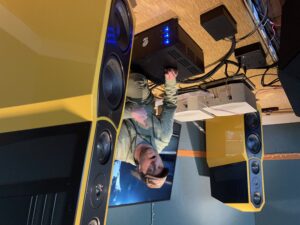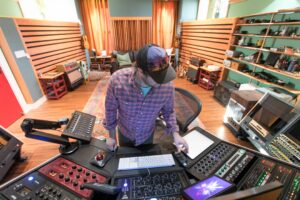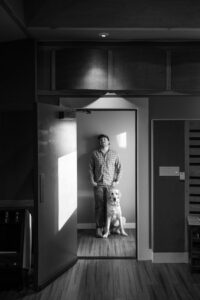Torus Power’s RM 60 BAL Toroidal Isolation Power Transformer breathes life into a mixing studio with compromised power.
Red Vault Audio is a diverse audio production house specializing in the sonic creation and enhancement of music and media. It’s owned and operated by Pete Morse, who works with musicians, videographers, agencies, and other businesses to help “make things sound better.”
You can see where the studio gets its name—it’s painted bright red, a 540-square-foot 2016 addition to Pete’s 1820s home—one of the oldest historical buildings in South Portland, Maine.
“I had a commercial space, but I wanted to be able to work near my family and mix into the night,” says Pete.
The home is so old, it has been through several incarnations of construction over the years. For example, there is an old basement with stone as the foundation, and later, concrete was poured. “There is a crazy electrical system down there that I’m still trying to figure out, weeding out the old wiring and replacing it with new,” says Pete. The electricity was definitely affecting what I was hearing in the studio, where I have a pretty nice HiFi system, with EgglestonWorks speakers, an expensive cabling system, and Jones Audio amplifiers that are all rigged in collaboration with my mixing desk, where I am able to hear things pretty articulately.”
That hi fi system, combined with the acoustics designed by Lou Clark of Sonic-Space, make the room very accurate. Pete, however, was on the quest for an even better sound. “It has led me to experiment, and my one of my biggest revelations was trying out different interconnects and even power cables.”
Despite the raging debate of whether or not you can hear sonic difference by using “better” cables, Pete did notice a difference. “With a system as articulate as mine, I can hear these little nuances in the audio and to hear that via cabling… it got me thinking about other things I could do to improve my system even more.”
Pete consulted with his “HiFi guru” Anthony Chiarella, who had previously advised him on cabling options and helped facilitate the purchase of his EgglestonWorks speakers. Anthony told Pete that one of the most significant things Pete could do to “breathe life into the system” was to add a Torus Power Toroidal Isolation power transformer.
That’s when Pete contacted Torus Power and started working with Ross Whitney, Technical Support Specialist/Customer Support Manager at Torus Power.
“Ross helped me learn about the different options and gave me his two cents on what the best way was to power everything in my studio, and I have some unusual equipment, like Jones amplifiers that run off 20-amp circuits. Also, the amount of juice I was getting to my studio was a challenge. I don’t think the amps were seeing what they should and were starved a little bit.”
 Red Vault Audio’s equipment list dictated the ideal Torus Power unit, and Ross suggested the Torus Power RM 60 BAL. The RM 60 BAL is a 60 Amp isolation transformer with three 20 Amp output circuits. Pete used two of the banks on the RM 60 to power each Jones amplifier effectively.
Red Vault Audio’s equipment list dictated the ideal Torus Power unit, and Ross suggested the Torus Power RM 60 BAL. The RM 60 BAL is a 60 Amp isolation transformer with three 20 Amp output circuits. Pete used two of the banks on the RM 60 to power each Jones amplifier effectively.
“The amps before were fantastic, plugged directly into the wall, but they had a little bit of noise in them. I did a bunch of tests, plugging them into the wall and then the RM 60 and back again, and the results were amazing,” says Pete. “Just the impact of the bass with the RM 60 was just so riveting. It’s so powerful to the point where everything before the RM 60 felt compressed and lifeless. With wall power, the transients weren’t popping out the way they did with RM 60, it was unbelievable.”
Sometimes it’s hard to put your finger on the exact differences are you hear before and after plugging in a Torus Power. But not for Pete’s well-trained ears. “You get an unbelievable amount of separation between instruments, the stereo image increased, and transients in the lower register are able to hit hard, freeing up space….I could hear the dynamics come to life..”

You get an unbelievable amount of separation between instruments, the stereo image increased, and transients in the lower register are able to hit hard, freeing up space….I could hear the dynamics come to life.
 He adds, “I’ve been super pleased with this investment and loving what it’s done for my system. Initially, I noticed the power it brought to my speakers and playback system, which blew me away. I noticed improvement on the audio processing side of things too, when mastering and mixing. Dynamics became clearer, the high-end smoother and a slight increase in perceived loudness. I think this had to do with the transient response really allowing more punch and separation within the elements of the mix. Therefore, the imaging became much more refined and life like almost 3-D.”
He adds, “I’ve been super pleased with this investment and loving what it’s done for my system. Initially, I noticed the power it brought to my speakers and playback system, which blew me away. I noticed improvement on the audio processing side of things too, when mastering and mixing. Dynamics became clearer, the high-end smoother and a slight increase in perceived loudness. I think this had to do with the transient response really allowing more punch and separation within the elements of the mix. Therefore, the imaging became much more refined and life like almost 3-D.”
In the end, Pete is extremely happy with his purchase, and the overall experience he has had when purchasing the RM 60: “My communication with Torus and Ross has been just fantastic, probably the best customer service that I’ve had with anything I’ve dealt with in my studio ventures and purchasing equipment!”
We can’t wait to hear what’s next from Pete and Red Vault Audio. We know it’s going to sound incredible!
Equipment List
Amps:
Jones PA M300s
Speakers:
EgglestonWorks Vigintis
Outboard gear:
Dangerous: Master (has separate power supply), Bax, Liason and Dangerous Compressor, 2-Bus +
Knif: Eksa (has a separate power supply), Soma (tube EQ) and Vari-Mu II (tube compressor),
Requisite L2M Mark III (with separate tube power supply RTS-4A), Bricasti M7 reverb
Converters:
Crane Song Hedd Quantum / Dangerous Convert 8 / Apogee Symphony / Avid HD IO
Monitoring:
Crane Song Avocet IIA / Little Labs Monitor
Preamps
Juggernaut JT656 / Groove Tubes Vipre / Millenia STT-1 / Great River MP2 / Focusrite ISA 428 / API lunchbox
Computer:
Mac Pro
Power Cables:
Pangea
Interconnects:
Requisite
Nordost
Shunyata

